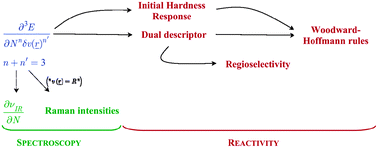Conceptual DFT: the chemical relevance of higher response functions
Abstract
In recent years conceptual density functional theory offered a perspective for the interpretation/prediction of experimental/theoretical reactivity data on the basis of a series of response functions to perturbations in the number of electrons and/or external potential. This approach has enabled the sharp definition and computation, from first principles, of a series of well-known but sometimes vaguely defined chemical concepts such as electronegativity and hardness. In this contribution, a short overview of the shortcomings of the simplest, first order response functions is illustrated leading to a description of chemical bonding in a covalent interaction in terms of interacting atoms or groups, governed by electrostatics with the tendency to polarize bonds on the basis of electronegativity differences. The second order approach, well known until now, introduces the hardness/softness and Fukui function concepts related to polarizability and frontier MO theory, respectively. The introduction of polarizability/softness is also considered in a historical perspective in which polarizability was, with some exceptions, mainly put forward in non covalent interactions. A particular series of response functions, arising when the changes in the external potential are solely provoked by changes in nuclear configurations (the “R-analogues”) are also systematically considered. The main part of the contribution is devoted to third order response functions which, at first sight, may be expected not to yield chemically significant information, as turns out to be for the hyperhardness. A counterexample is the dual descriptor and its R analogue, the initial hardness response, which turns out to yield a firm basis to regain the Woodward–Hoffmann rules for pericyclic reactions based on a density-only basis, i.e. without involving the phase, sign, symmetry of the wavefunction. Even the second order nonlinear response functions are shown possibly to bear interesting information, e.g. on the local and global polarizability. Its derivatives may govern the influence of charge on the polarizability, the R-analogues being the nuclear Fukui function and the quadratic and cubic force constants. Although some of the higher order derivatives may be difficult to evaluate a comparison with the energy expansion used in


 Please wait while we load your content...
Please wait while we load your content...